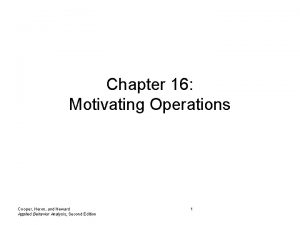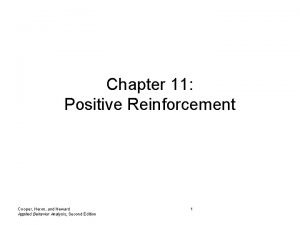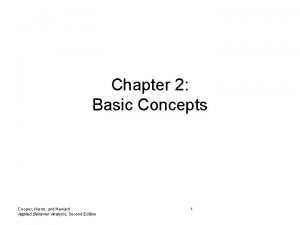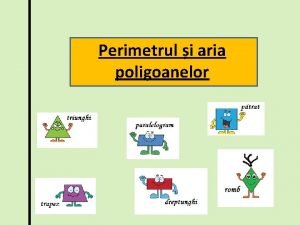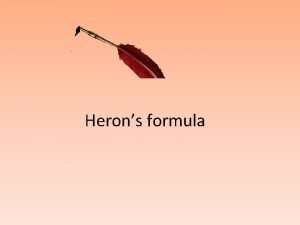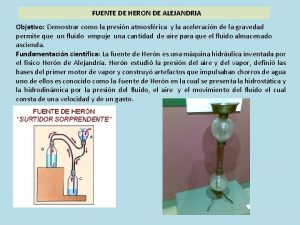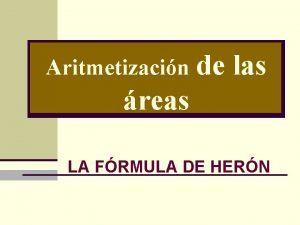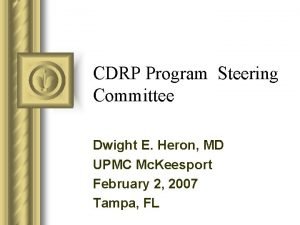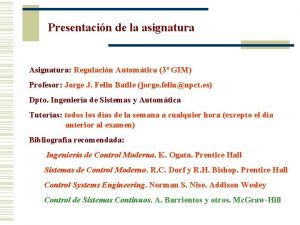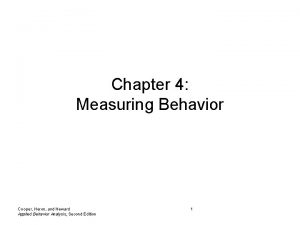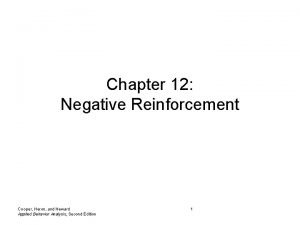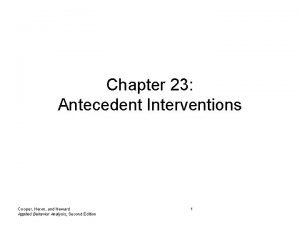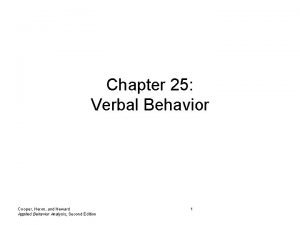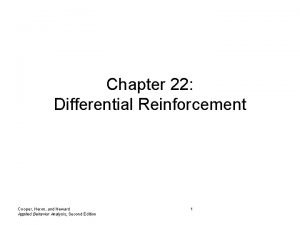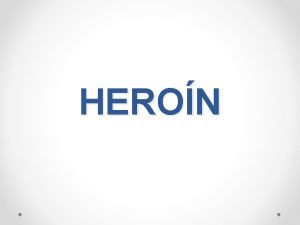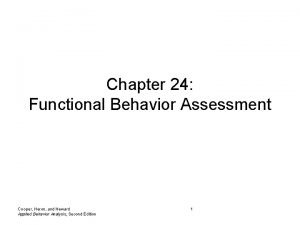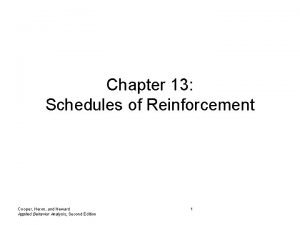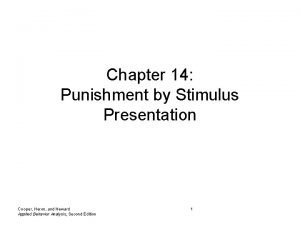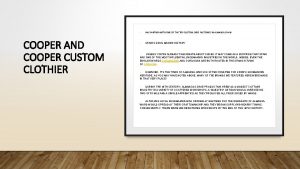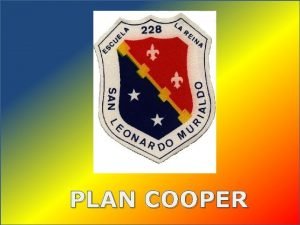Chapter 19 Shaping Cooper Heron and Heward Applied























- Slides: 23

Chapter 19: Shaping Cooper, Heron, and Heward Applied Behavior Analysis, Second Edition 1

What is Shaping? • A process in which one – Systematically and differentially reinforces – Successive approximations to a terminal behavior • Used to help learners acquire new behaviors Cooper, Heron, and Heward Applied Behavior Analysis, Second Edition 2

Differential Reinforcement • Some members of a response class are reinforced (responses that are successively closer to the terminal behavior) • Other members of that response class (responses that are not closer to the terminal behavior) Cooper, Heron, and Heward Applied Behavior Analysis, Second Edition 3

Response Differentiation • Involves two components: – Differentially reinforce behaviors that resemble the terminal behavior – Carefully changing the criterion for reinforcement • Result – Increase in behaviors successively closer to terminal behavior – Decrease in behaviors that are not successively closer to terminal behavior Cooper, Heron, and Heward Applied Behavior Analysis, Second Edition 4

Shaping Diagrammed Ø Assume we want to teach a child to turn on the cold water tap in order to get a drink of water. Ø Assume the child already walks to sink and looks at it when he/she is thirsty. Ø Shaping might proceed like this: EO SD Response SR+ Deprived of water for a long period of time Tap on faucet marked with blue dot or letter “C” Walk to sink and look at it Cold water presented Walking to sink and looking at it maintains Response already in repertoire Cooper, Heron, and Heward Applied Behavior Analysis, Second Edition 5 Copyright © 2008 by Pearson Education, Inc. All rights reserved

Shaping Diagrammed Ø Shaping step 1: EO SD Response SO Deprived of water for a long period of time Tap on faucet marked with blue dot or letter “C” Walk to sink and look at it Cold water withheld EO SD Response SR+ Deprived of water for a long period of time Tap on faucet marked with blue dot or letter “C” Point to tap Cold water presented Cooper, Heron, and Heward Applied Behavior Analysis, Second Edition Walking to sink and looking at it when deprived of water decreases Pointing to tap when deprived of water increases 6 Copyright © 2008 by Pearson Education, Inc. All rights reserved

Shaping Diagrammed Ø Shaping step 2: EO SD Response SO Deprived of water for a long period of time Tap on faucet marked with blue dot or letter “C” Point to tap Cold water withheld EO SD Response SR+ Deprived of water for a long period of time Tap on faucet marked with blue dot or letter “C” Touch tap Cold water presented Cooper, Heron, and Heward Applied Behavior Analysis, Second Edition Pointing to tap when deprived of water decreases Touching tap when deprived of water increases 7 Copyright © 2008 by Pearson Education, Inc. All rights reserved

Shaping Diagrammed Ø Shaping step 3: EO SD Response SO Deprived of water for a long period of time Tap on faucet marked with blue dot or letter “C” Touch tap Cold water withheld EO SD Response SR+ Deprived of water for a long period of time Tap on faucet marked with blue dot or letter “C” Grasp tap Cold water presented Cooper, Heron, and Heward Applied Behavior Analysis, Second Edition Touching tap when deprived of water decreases Grasping tap when deprived of water increases 8 Copyright © 2008 by Pearson Education, Inc. All rights reserved

Shaping Diagrammed Ø Shaping step 4: EO SD Response SO Deprived of water for a long period of time Tap on faucet marked with blue dot or letter “C” Grasp tap Cold water withheld EO SD Response SR+ Deprived of water for a long period of time Tap on faucet marked with blue dot or letter “C” Turn tap Cold water presented Cooper, Heron, and Heward Applied Behavior Analysis, Second Edition Grasping tap when deprived of water decreases Terminal Behavior Turning tap when deprived of water increases 9 Copyright © 2008 by Pearson Education, Inc. All rights reserved

Dimensions of Behavior that can be Shaped • Topography – Form of the behavior • Frequency – Number of responses per unit of time • Latency – Time between onset of antecedent stimulus and the occurrence of the behavior • Duration – Total elapsed time for the occurrence of the behavior • Amplitude – Magnitude Cooper, Heron, and Heward Applied Behavior Analysis, Second Edition 10

Successive Approximations • An intermediate behavior – Prerequisite for terminal behavior or – Higher order member of the same response topography Cooper, Heron, and Heward Applied Behavior Analysis, Second Edition 11

Shaping Across and Within Response Topographies • Across response topographies – Topography of behavior changes during shaping – Behaviors are still members of the same response class • Within response topographies – Topography of behavior remains constant – Another measurable dimension of behavior is changed (e. g. , duration of the behavior) Cooper, Heron, and Heward Applied Behavior Analysis, Second Edition 12

Positive Aspects of Shaping • Teaches new behaviors • A positive approach to teaching • Can be combined with other procedures, such as chaining Cooper, Heron, and Heward Applied Behavior Analysis, Second Edition 13

Limitations of Shaping • Can be time consuming • Progress is not always linear and may be erratic • Requires a skillful trainer, who can recognize subtly closer approximations • Can be misapplied (problem or harmful behaviors can be accidentally shaped) Cooper, Heron, and Heward Applied Behavior Analysis, Second Edition 14

Shaping vs. Fading • Both change behavior gradually – Shaping via changing response requirements – Fading by changing antecedent stimuli Cooper, Heron, and Heward Applied Behavior Analysis, Second Edition 15

Increasing Efficiency of Shaping • Combine with a discriminative stimulus (e. g. , a prompt) – Verbal cues – Physical guidance – Models Cooper, Heron, and Heward Applied Behavior Analysis, Second Edition 16

Guidelines for Implementing Shaping • Consider nature of behavior to be learned and resources available – How far away is current performance from terminal behavior? • This might influence how long shaping will take – What is the availability of staff and other resources? • Remember, this is a labor intensive procedure Cooper, Heron, and Heward Applied Behavior Analysis, Second Edition 17

Guidelines for Implementing Shaping • Select the Terminal Behavior – The ultimate criterion for selecting a behavior for change: • How will the behavior change contribute to the learner’s independence in gaining reinforcement? – Define the terminal behavior precisely • Then you’ll know when the behavior has occurred Cooper, Heron, and Heward Applied Behavior Analysis, Second Edition 18

Guidelines for Implementing Shaping • Determine Criteria for Success – How accurate, fast, long, or intensely should the behavior be performed? Under what conditions should it be performed? – Establish norms by • Consulting literature • Observing similar peer group Cooper, Heron, and Heward Applied Behavior Analysis, Second Edition 19

Guidelines for Implementing Shaping • Analyze the Response Class – Identify the approximations that might be emitted during training • Trainer is in a better position to “stay ahead of his/her subject” – Can be done by: • Consulting experts in the field • Use published literature • Use videotape of peers to analyze components of a behavior • Perform the target behavior yourself Cooper, Heron, and Heward Applied Behavior Analysis, Second Edition 20

Guidelines for Implementing Shaping • Identify the First Behavior to Reinforce – Behavior should already occur at some level – Behavior should be a member of the targeted response class Cooper, Heron, and Heward Applied Behavior Analysis, Second Edition 21

Guidelines for Implementing Shaping • Eliminate Interfering Stimuli – Eliminate distractions during training • Proceed in Gradual Stages – Be prepared for decrements in performance when you increase criteria Cooper, Heron, and Heward Applied Behavior Analysis, Second Edition 22

Guidelines for Implementing Shaping • Limit the Number of Approximations at Each Level – Lest the behavior become too firmly established • Continue Reinforcement When the Terminal Behavior is Achieved – The behavior will be lost if the terminal response is not reinforced Cooper, Heron, and Heward Applied Behavior Analysis, Second Edition 23
 Examples of cmo-t
Examples of cmo-t Cooper heron and heward
Cooper heron and heward Shaping within topography example
Shaping within topography example Cooper heron heward
Cooper heron heward Chapter 14 section 3 shaping evolutionary theory
Chapter 14 section 3 shaping evolutionary theory Chapter 15 section 3 shaping evolutionary theory
Chapter 15 section 3 shaping evolutionary theory Aria triunghiului
Aria triunghiului Historia de la luz
Historia de la luz Leslie heron beauchamp
Leslie heron beauchamp Triangle formula area
Triangle formula area Heron's formula
Heron's formula Heronova fontána
Heronova fontána Fuente de heron experimento
Fuente de heron experimento Diamond css
Diamond css Area formula de heron
Area formula de heron Heron glen golf course
Heron glen golf course 10740 north gessner road
10740 north gessner road Heron von alexandria geboren
Heron von alexandria geboren Heron bird
Heron bird Dwight heron
Dwight heron John heron theory
John heron theory Sherifia heron
Sherifia heron Lazo cerrado
Lazo cerrado Babylonisches wurzelziehen beispiel
Babylonisches wurzelziehen beispiel
